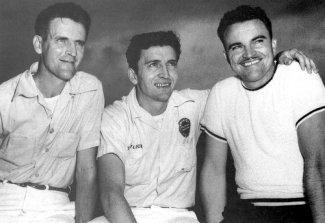
The Flock Brothers, Bob (left), Tim (center) and Fonty (right) were terrors and winners on the sandy beach and road course at Daytona. Photo courtesy Frances Flock
By Brandon Reed
Posted in Feature Stories 1/20/12
As we close in on the annual running of the Daytona 500, thoughts go back to at time prior to the building of the great speedway, when drivers did battle on the hard packed sands of Daytona Beach to prove who was the best.
Many drivers from Georgia made the trek south each winter to compete on the beach, but few saw the success as the three fabulous Flock brothers, Bob, Fonty and Tim.
The three brothers, who were always among the favorites to win in early southern stock car circles, saw much success on the beach, and were always in the thick of the action.
Bob, piloting a car for famed Georgia car owner Raymond Parks, started the family tradition of winning on the beach on March 9, 1947. It was the first of many wins at Daytona for the Fabulous Flocks.
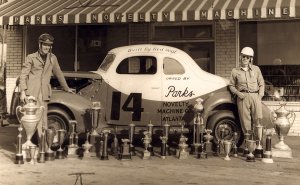
Bob Flock, pictured left, and Red Byron, pictured right, were potent drivers for Raymond Parks. Photo courtesy Eddie Samples
Bob would back up that first beach win with another in the next event, held on August 17. In doing so, he made what well may be the most incredible charge in the history of auto racing.
Starting 31st due to being unable to qualify,Bob Flock flew through the field to take the lead before the FIRST MILE of the race had been completed. After taking the top spot, Bob never looked back, leading every lap of the event for the win.
The feat led local sportswriter Bernard Kahn to dub Bob Flock “The Wizard of Whiz”. Flock credited the power to car builder Red Vogt.
The race was also significant for Bob’s brother Fonty, who was running his first race on the beach since being injuries at the circuit back in 1941. Fonty would finish in the top 20 piloting a Ford. He would go on that year to with the NCSCC points title.
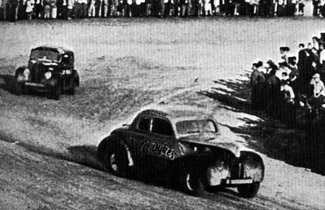
Fonty Flock led most of the Feb. 15, 1948 event at Daytona Beach, but crashed hard after a spindle broke on his Ford. Photo courtesy GRHOF
Fonty would run strong in the first race under the new NASCAR banner was run at Daytona Beach on Feb. 15, 1948. He led the first 60 miles of the event, and was leading with 18 laps to go when his Ford broke a spindle. His car flipped end over end, landing in the palmetto bushes. Flock escaped injury. Fellow Georgian Red Byron would score the victory.
Of note is the third place finisher. Car owner Raymond Parks is credited with the third place effort, but it should be noted that Bob Flock drove in relief of Parks after his own car fell out. The race also marked the first beach event for Tim Flock, youngest of the three brothers. It marked the first time three brothers competed in the same event at Daytona.
Seven years after the crash that left him badly injured, Fonty Flock finally got his revenge at Daytona Beach in the August 8, 1948 event. Fonty started his Hugh Babb owned Ford in the third position, and was trailing Red Byron when a rock punctured Byron’s oil pan with four laps remaining. Fonty was more than a lap down at the time, and had to pass Byron’s car twice as it sat still to take the lead. Fonty would sail on to victory, averaging 73.92 miles an hour in the process.
A few years later, things would not go in the brother’s favor on more than one occasion on the beach.
It appeared that Tim Flock was the winner of the Modified-Sportsman event on Feb. 9, 1952. Tim streaked across the finish line 18 seconds ahead of Atlanta’s Jack Smith. Smith, however, was flagged as the winner. Flock called for a scoring check, which showed that he had indeed won the race. Smith was placed in second.
Smith, however, had other ideas.
When Flock showed up at the beach, his car did not have roll bars. The rulebook for 1952 stated that roof supports would be mandatory for all events. Bill France had some of his track workers use two-by-fours to construct a roll bar out of wood.
After the race, Smith went to the NASCAR officials to protest the wooden roll bars. The officials took the win away and gave it to Smith. Flock was given last place.

Fonty Flock would run out of gas just short of a win in Grand National competition at Daytona in 1953. Photo courtesy GRHOF
One year later, it looked like Fonty Flock had the field covered in the Feb. 15, 1953 Grand National event at Daytona. Fonty led 38 of the event’s 39 laps driving for fellow Georgian Frank Christian. But on the final circuit, Flock’s Oldsmobile ran out of gas. Slick Smith, Fonty’s teammate, pushed Flock’s car around to the pits, while Bill Blair cruised past for the win.
In Feb. 21, 1954 Grand National event, Tim Flock, piloting an Oldsmobile owned by Kentucky Colonel Ernest Woods, took the lead of the event on the third lap.
Flock dominated most of the event while being in constant communication with the pits via a two-way radio, the first time such was used in a Grand National event. Flock took the checkered flag by almost a minute and a half.
But in post race inspection, officials found the butterfly shaft on Flock’s carburetor had been soldered to keep it from vibrating loose. Flock was disqualified, and the win was given to Lee Petty.
It was the second time in three years that Tim Flock had been disqualified. It was the second time in two years that the Flock family was denied victory on the beach.
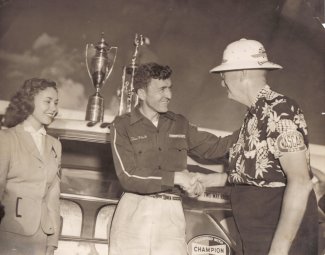
Tim Flock is congratulated in victory lane after the 1954 Grand National event on the beach. Flock would later have the win stripped from him hours later. Photo courtesy Frances Flock.
Flock argued that the soldering gave him no advantage and only prevented potential problems. The race officials did not agree. Flock swore he was through with NASCAR, and sat out most of the 1954 season.
After running a Pure Oil gas station in Atlanta for a year, Tim Flock accepted the invitation of some friends to return to Daytona Beach as a spectator in February of 1955.
As he sat watching the cars go by on the beach, he saw a particularly quick 1955 Chrysler 300 power its way around the course.
Flock told his friends that if “I had that car, I’d win this race again this year.”
Standing within earshot was Tommy Hagood, a local outboard engine dealer. He introduced himself to Flock after recognizing him as the man flagged the winner of the ’54 race, and offered to introduce him to the car’s owner, Mercury Outboard engine company president Carl Kiekhafer.
The two were introduced, and the rest is history.
Flock shattered the qualifying record by nearly seven miles an hour with a pass through the measured mile at 130.293 mph.
But there was a problem, and Flock had spotted it right away. The Chrysler was equipped with an automatic transmission, which would slow the car coming out of the turns.
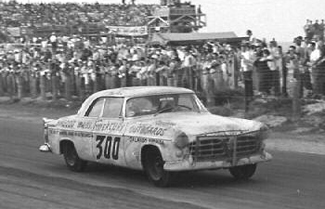
Tim Flock powers his way around the beach and road course at Daytona in 1955. Photo courtesy Frances Flock
As the race unfolded, Fireball Roberts, driving the Red Vogt tuned Fish Carburetor Buick, took an early lead, with Flock giving chase in the powerful Chrysler 300. Flock would close on Roberts down the straightaways, but would lose contact with him on the turns due to the automatic transmission. Roberts was flagged the winner 14 seconds ahead of Tim.
But in post race tech, officials discovered that the push rods were not stock. 24 hours after finishing second, Tim Flock got his victory and his revenge. He won his first race at Daytona Beach, joining his brothers Fonty and Bob in the history books.
When the 1956 season rolled around, it was more success for the Fabulous Flocks on the sands of Daytona Beach.
Tim Flock started by winning the pole for the Modified-Sportsman event with a speed of 137.405 mph in a 1946 Chevy Coupe powered by an engine out of a 1956 Oldsmobile.
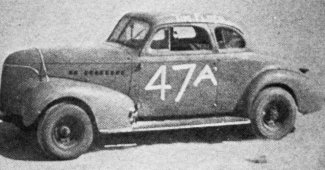
Tim Flock piloted this unique Chevy modified to victory in 1956.
The engine was set back a full 26 inches in the modified, putting the drivers’ seat where the back seat usually would be.
Tim was dubbed “America’s Number One Back Seat Driver”.
Tim took control of the Feb. 24 event early, and was challenged only by Speedy Thompson’s Ford. Thompson’s day ended with a blown engine, and Flock moved away for the win. Tim led every lap en route to the win, finishing just over seven miles ahead of second place Glenn Wood.
When the engines fired on the beach on Feb. 26 for the Grand National race, all eyes were again on Tim Flock.
He put his Chrysler on the pole for the event with a speed of 135.747 mph, over six miles an hour faster than second place.
Flock controlled the race, giving the lead up only on pit stops. He finished 57 seconds ahead of second place Billy Myers. Flock commented afterward that it was easier this year due to having a manual transmission in the car.
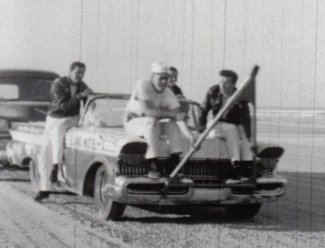
Tim Flock and members of his crew make their way to victory lane after the 1957 convertible series event on the beach. Photo courtesy Frances Flock
Tim would have one last hurrah on the sands of Daytona Beach. Driving a factory supported Mercury convertible for Bill Stroppe, Flock dueled convertible series aces Joe Weatherly and Curtis Turner on Feb. 16, 1957 on the beach.
Mechanical failures and pit stop woes on the parts of Turner and Weatherly gave Tim the edge, as he finished 53 seconds ahead of Weatherly for the victory.
It would be the last win for Tim Flock in his career and the final win on the beach for the Flock brothers.
While the sight of cars rushing up and down the old Daytona Beach course is a thing of the past, its memories live on. So do those of the Flock brothers. All three are members of the Georgia Racing Hall of Fame, with Tim belonging to several other Halls of Fame.
When the engines fire this year at the speedway in Daytona, the spirit and the sound will surely carry over to the beach, where the Flock brothers made their mark on the record books.
Brandon Reed is the editor and publisher for Georgia Racing History.com.
Questions, comments, suggestions? Email us!
This website is not affiliated with or endorsed by the Georgia Racing Hall of Fame or the Georgia Auto Racing Hall of Fame Association, Inc. All content is the intellectual property of the individual authors. All opinions are those of the individual authors. Please do not repost images or text without permission.
